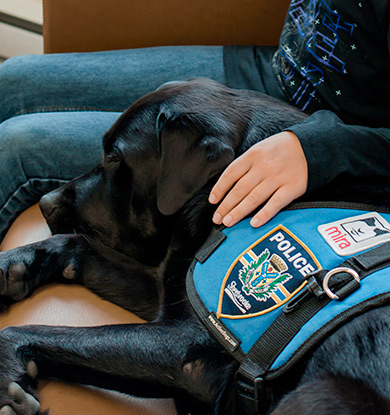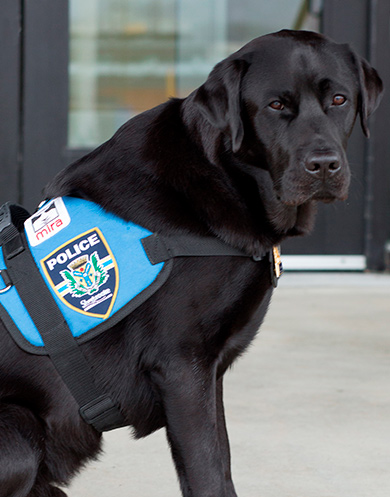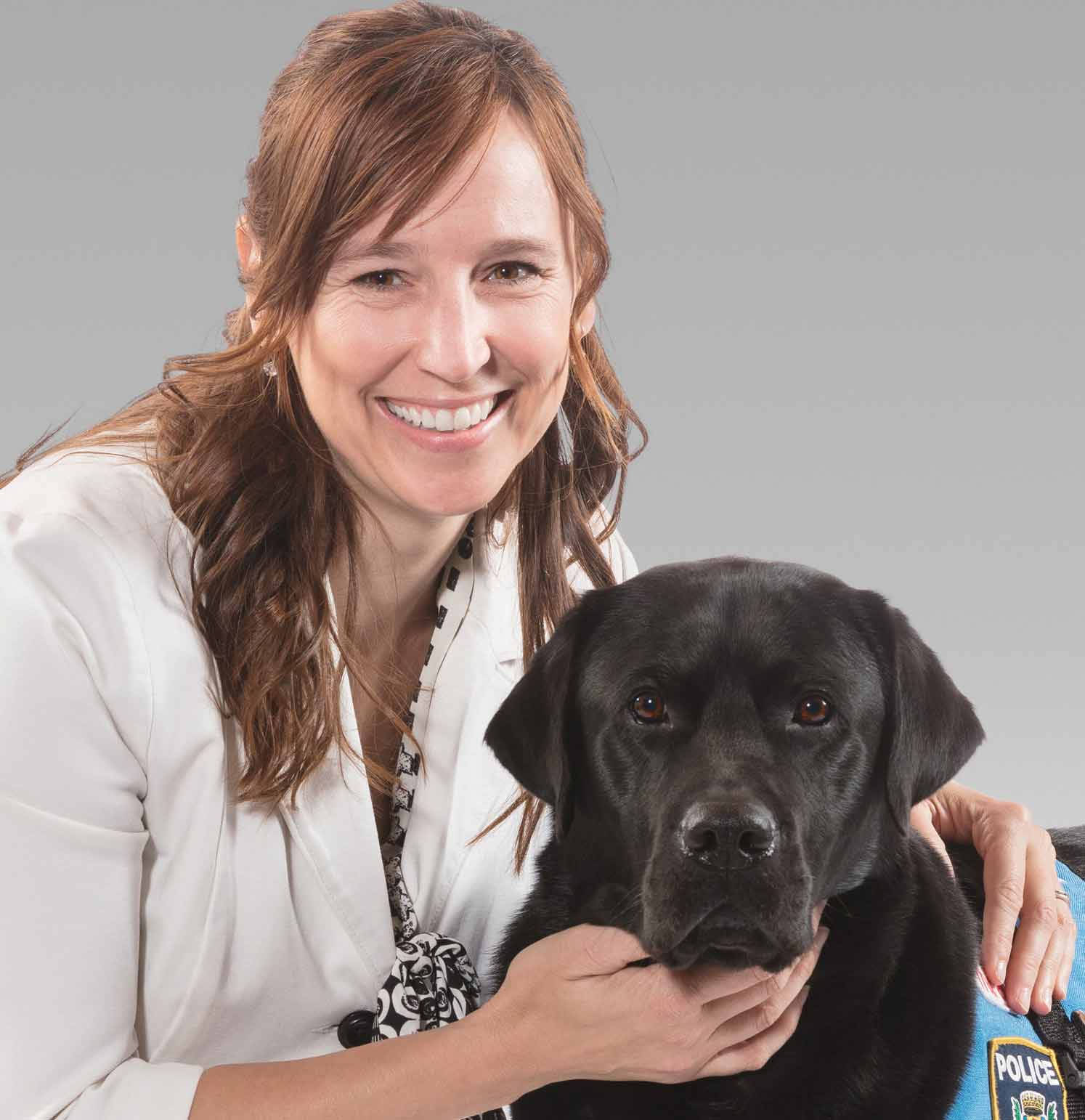
A day in the life of Kanak, an emotional support dog
Published October 30, 2018.

Mondou Academy
Mondou employee training specialist
For a child who is a crime victim, being interviewed by an investigator at a police station is not easy. Learn how Kanak makes these difficult moments easier.
How does Kanak manage to relax victims?
We don’t ask Kanak to do anything. He lies down next to the victim and puts his head in the child’s lap so he or she can easily pet him. It’s Kanak’s presence, calm temperament, warmth, gentleness and soft gaze that comfort the victim. The dog does nothing, but it makes all the difference. Whether during an interview between an investigator and a victim, a meeting with the crown prosecutor or court testimony, Kanak remains still, next to the victim.

Was the dog trained?
Kanak spent a year with a host family before going through placement tests at the Mira Foundation. Then, he received approximately three months of basic training to learn the basic commands. When Kanak arrived at the police station, we did several interview simulations with my children to teach him how lie next to them and put his head on their lap. Kanak quickly understood his job. In this type of role, the dog’s temperament counts for much more than training.
What types of situations call for Kanak’s emotional support?
Anyone who is the victim of or witness to a crime can use Kanak’s services. Most are children who have been physically or sexually abused.
The dog can also accompany community police officers on visits to schools, seniors’ residences, youth centres and women’s shelters. The dog’s presence facilitates communication, makes the officers more approachable and helps them deliver their prevention messages more easily. Most people like dogs, and the animals’ presence breaks down barriers, including those created by uniforms.
For example, Kanak took part in meetings with young offenders and runaways. He allowed us to approach these groups, who generally do not respond favourably to police presence. We were able to describe the valuable role that Kanak plays in the City of Sherbrooke’s police department. The dog’s presence captured their attention, created a more relaxed atmosphere and made for friendly meetings. It was easier for us to share our prevention messages about such topics as pimps’ recruitment strategies.
Why does Kanak wear a vest?
First, the vest replaces Mira Foundation’s usual work harness. When Kanak is wearing the vest, he knows that he is working and that he has to be on his best behaviour, although he is usually very disciplined. The second reason is that the vest helps identify the dog. When we have to go to the courthouse, the hospital or any other place, people see the badges on Kanak’s vest that identify him as a police dog and a Mira dog.
How does Kanak get involved?
When the investigator contacts the victim or the victim’s family by phone for the first time and sees that the person is anxious, stressed or hesitant, the investigator suggests bringing Kanak on board. We never impose the dog’s presence. We also have to make sure that the person is not afraid of or allergic to dogs, and is genuinely interested in having the dog there.

At the first meeting, I introduce the dog to the victim and the victim’s family. I talk about his role, the Mira Foundation, the reason for the vest, the possible benefits and how the interview will be conducted. Also, if the child is familiar with the TV show Paw Patrol, I mention that Kanak is just like Chase on Paw Patrol.
I try to answer any questions about the dog to avoid having the victim ask those questions during the interview. When I introduce Kanak to the child, I mention that, during the interview with the investigator, Kanak may fall asleep while being petted, and start dreaming, snoring or farting. This makes the child laugh, and creates a more relaxed atmosphere.
How does Kanak help people overcome difficulties?
By simply being present, Kanak calms the victim down and makes the person feel safe. He helps break the ice and creates a relationship of trust between officers of the court and the victim. When a parent tells a child about having to meet with an investigator or attorney to explain what happened, the child becomes upset. If, however, the parent mentions that a dog will accompany the child to all the meetings, this motivates the child, who can now think about the dog instead of focusing on the meeting.
Kanak optimizes police intervention by introducing a positive element to a traumatic event. He is like a friend who doesn’t judge or criticize, and gives full affection and attention during difficult times. By relieving the victim’s stress, he makes it easier for the person to focus on providing a detailed explanation of what happened.
Over time, I discovered that Kanak’s presence during court testimony gave children the courage to face their abusers, and helped them manage their emotions and testify in court. In the end, victims were proud of themselves and able to begin the process of personal reconstruction.

Tell us about a situation in which Kanak supported a person in need
Co-workers of mine had to conduct an emergency interview with a young victim of sexual abuse that was reported to Youth Protection (DPJ) by a third party. The adolescent appeared to have autism spectrum disorder. She wouldn’t answer any questions, except for a barely audible yes or no, and wouldn’t look the investigator or the DPJ representative in the eye. When the young girl was introduced to Kanak, she began interacting with the adults. She had two dogs at home, and her face just lit up.
As soon as the young girl met Kanak, she began to relax. Throughout the interview, she petted Kanak, who appeared to calm her and provide genuine comfort. The dog helped her overcome the embarrassment that was preventing her from opening up. The investigator’s gentle approach and tremendous patience, combined with the dog’s presence, made it possible to gather the young girl’s testimony regarding the sexual abuse that she had suffered.
At the time, Kanak had only a few months of work experience and he really impressed my co-workers. During the three hours he spent with the young girl, he behaved perfectly, was calm and didn’t move. This was the DPJ representative’s first experience with a support dog and, after the interview, she had only good things to say.
The abuser subsequently pled guilty to the charges. Without the victim’s testimony, he would never have been charged. Kanak did an outstanding job, allowing us to demonstrate the importance of having a dog present in this type of case.

Entrevue avec Mélanie Bédard,
sergente-détective du service de police de Sherbrooke.
Interview with Mélanie Bédard,
detective from du Sherbrooke Police.